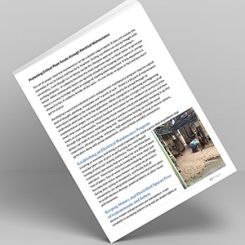Proper grinding and removal of waste and debris from the production stream is one of the most important steps to maintaining an efficient and reliable oil refining operation. Debris accumulation can cause damage to the pipeline and pumps as well as create safety hazards for operators who must clear the waste by hand after it clogs the pipeline. Incorporating a waste grinder within a midstream application, however, can help eliminate debris, maintain proper flow rates and minimize costly downtime and wasted energy. Specifically for bitumen processing, bits of plants and other organics extracted from the oil sands cause a great deal of wear and tear on the production pipelines. A proper waste grinder offers both a reduction solution for those materials, along with elimination of the safety concerns posed by clogged pipelines and manual unclogging. With the proper grinding technology at the right location, oil extraction and refinery efforts can proceed without the stress of equipment failure.
 Figure 1. Waste grinders improve midstream flow. (Images courtesy of JWC Environmental)
Figure 1. Waste grinders improve midstream flow. (Images courtesy of JWC Environmental)Waste Grinders in Action
Suncor Energy in Alberta, Canada, mines and extracts crude oil from the area’s vast oil sand deposits. The need for oil sand development is expected to increase in the years to come as conventional fuel and energy supplies are depleted. As petroleum production in North America in general continues to increase to meet demand, a completely streamlined, flawless production line is crucial for the overall success and future of the industry. As the following case study from Suncor Energy indicates, equipping a production line with a waste grinder is essential to the productivity of these midstream processes. Oil sand is a mixture of bitumen, sand and water. Because it does not flow like conventional crude oil, it must be mined or heated underground before it can be processed. Stuncor’s system for mining oil sand involves extracting the sands from an open pit mine, transporting it to an extraction facility and then mixing it with hot water so the oil can separate from the sand and rise to the top of the separation tank. Once the oil separates from the water, it creates an extremely hot froth that is mixed with Naphtha for better flow through the rest of the extraction process. During each extraction phase, more raw materials—such as wood, roots and other organic matter—separate from the oil. This material would cause the pumps at the extraction facility to clog, resulting in unplanned downtime throughout the production line. Workers would continually have to unclog the equipment and pipes. The time lost to unnecessary maintenance costs tens of thousands of dollars in lost revenue. Understanding the gravity of this continuing problem, a mill wright at Suncor contacted a solids reduction equipment provider about a solution that would eliminate the constant clogging and allow oil to flow freely through the production line. The pump company recommended the largest grinder in its product lineup. Figure 2. Waste reduction technologies help ensure the integrity of pipelines, protect equipment and create safer work environments.
Figure 2. Waste reduction technologies help ensure the integrity of pipelines, protect equipment and create safer work environments.

